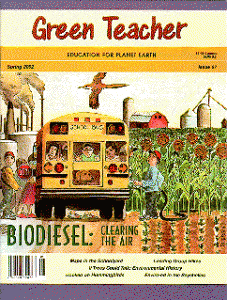Green Teacher 67, Spring 2002
 Features
Features
The Bus Stops Here: The Case for Biodiesel in School Buses by Steven T. Rao
Everyday, nearly 26 million students in the U.S. and Canada take the bus to school, and nearly 90% of these buses are powered by diesel fuel, whose emissions have been linked to asthma, cancer, premature death, neurobehaviorial impairment, memory loss and many other health problems. Steven Rao’s article makes the case for the use of biodiesel fuel as a safer, cleaner, biodegradable and economical alternative to diesel fuel. The fuel is growing in popularity, and several school districts throughout North America have already converted their school bus fleets to a biodiesel blend.
Why Teach About Biodiesel? by Richard Lawrence
Educators have an important role to play in promoting the transition away from fossil fuels by teaching about the need for alternative forms of energy and the options that are available. Richard Lawrence’s article offers ideas about how to incorporate lessons about biodiesel fuel across the curriculum, including information about how to produce in your own classroom. Internet sites about biodiesel are included at the end of the article.
From Bean to Beetle: Soy-powered Learning at Oak Forest High School by Gail Littlejohn
Biodiesel is fueling the engines of learning at Oak Forest High School in Oak Forest, Illinois, where teachers of plant science, chemistry, physics and technology have joined forces in an interdisciplinary research project focused on using soybean oil as an environment-friendly fuel.
Asphalt Artisans: Creating a Community Eco-map on the Playground by Paul Fieldhouse and Lisa Bunkowsky
Describes an multidisciplinary eco-count project, in which students, teachers, parents and other volunteers painted an eco-map of their neighbourhood on their school’s playground. The map included elements of the green environment, built environment, transport environment, living environment and litter and recycling. The Windsor Green project at once promoted learning about the local environment and urban ecology, helped to beautify the school and provided students with a giant game board right on their playground.
Hooked On Hummingbirds by Kim Bailey
Kim Bailey provides readers with a variety of ways to invite hummingbirds into your schoolyard. The article includes a quiz, active tag game, board game and resource section:
Hummingbird Quiz
Territorial Tactics
Migration Mishaps (game)
Design a Hummingbird Flower
Environmental History: If Trees Could Talk by Marsha Alibrandi, Lucy Lafitte, Cheryl Oakes and Steven Anderson
Arboreal Archives: Documenting Trees in Your Schoolyard
A School Tree Ordinance
Environmental history is a new field that can be defined as “the history of human interaction with the natural world”. Literally “hands-on history,” environmental history combines investigations of the natural environment with studies of material culture in order to create a deeper understanding of human-land relationships. The authors provide an introduction to this new subject, as well as a list of resources for further information. The two activities that accompany the article, “Arboreal Archives” and “A School Tree Ordinance” offer good places to begin an investigation of the environmental history of your school.
The Caboose Hike: Enhancing Outdoor Learning by Gloria Seirs
Naturalist-guide Gloria Seirs offers sage advice and clever techniques to make nature hikes both more enjoyable and more effective educational experience for students of all ages.
Regaining Paradise: Wildlife Clubs of Seychelles by Michele Martin
The Wildlife Clubs of Seychelles is a non-governmental volunteer organization in that island state that seeks involve young people in conservation. There is now a club in almost every primary and secondary school, as well as in several post secondary schools throughout Seychelles, where students engage in a range of activities such as recycling, habitat restoration in school grounds, tree planting, creative writing and artwork, hiking, snorkeling, visits to nature reserves and different island, research projects and exhibitions.
Inside the Internet: Population Studies on the Web by Katharine Isbell
And as always, over 20 new educational resources are profiled and evaluated in this issue of Green Teacher.
Leave a Reply
You must be logged in to post a comment.










